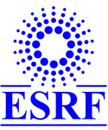
 |
www.esrf.fr |
The European Synchrotron Radiation Facility in Grenoble
(France) is Europe's strongest X-ray light source. It was inaugurated in 1994,
has about 600 staff members and is financed by 18 countries: Austria, Belgium,
Czech Republic, Denmark, Finland, France, Germany, Hungary, Israel, Italy, the
Netherlands, Norway, Poland, Portugal, Spain, Sweden, Switzerland and the United
Kingdom. Highly qualified scientific and technical experts welcome thousands of
scientists coming from more than 1000 research organisations every year to
conduct experiments at the European Light Source.
Since their discovery about a century ago, X-rays have been used in an
everincreasing number of experimental research areas and industrial applications
ranging from medical imaging in hospitals to solving the structure of the famous
double helix 50 years ago. Indeed, the high penetration power and the short
wavelength of X-rays, about the distance between atoms, make X-ray techniques
invaluable tools for revealing the hidden structure of matter down to the atomic
scale. Synchrotron radiation is a special kind of X-ray light with many orders
of magnitude higher brightness than that of conventional X-ray tubes.
Very intense, micrometer sized and extremely parallel beams are emitted by
electrons circulating in the storage ring with a speed close to that of light.
Exiting through beamports in the shield wall around the storage tunnel these
laser-like beams enter 40 highly specialised 'beamlines' situated in the
experimental hall of 1 km circumference. They are further conditioned by ultra-precise
X-ray optics such as mirrors with atomically flat surfaces and monochromator
crystals made of silicon. The X-ray beams can be focused to spots on the
nanometer scale, thousands of times smaller than the diameter of a human hair.
Special detectors, many two-dimensional, permit fast data recording. Each
beamline uses highly specialised methods such as diffraction, fluorescence
spectroscopy and imaging. Alone or in combination, these techniques allow the
researchers to gain valuable insight into not only the static structure of
matter, but also the dynamic behaviour of atoms and molecules on a timescale
down to the picosecond level.
Research at the ESRF covers a wide range of scientific fields including physics,
chemistry, biology, environmental and life sciences, medicine and materials such
as semiconductors, metal alloys and polymers. Researchers from industry are also
very interested in the experimental opportunities offered by the ESRF to study
pharmaceuticals, cosmetics, biomaterials and semiconductor components.